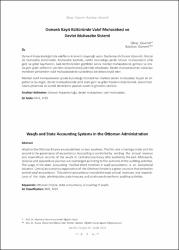Osmanlı Kayıt Kültüründe Vakıf Muhasebesi ve Devlet Muhasebe Sistemi
Künye
GÜVEMLİ, Oktay, & Batuhan GÜVEMLİ. "Osmanlı Kayıt Kültüründe Vakıf Muhasebesi ve Devlet Muhasebe Sistemi." Vakıflar Dergisi, 46 (2016): 9-21.Özet
Osmanlı İmparatorluğu’nda vakıfların iki önemli dayanağı vardır. Bunlardan ilki hukuk düzenidir. İkincisi
de muhasebe kontrolüdür. Muhasebe kontrolü, vakfın bulunduğu yerde tutulan muhasebenin yıllık
gelir ve gider kayıtlarının, kadı kontrolünden geçtikten sonra merkez muhasebesine gelmesi ve orada
gelir gider defterinin yeniden düzenlenmesi şeklinde olmaktadır. Devlet muhasebesinde kullanılan
merdiven yönteminin vakıf muhasebesinde kullanılması bir istisna teşkil eder.
Merkezî vakıf muhasebesinin içinde bulunduğu Osmanlı’nın merkezî devlet muhasebesi büyük bir örgüttür
ve bu örgüt, devlet muhasebesinde yıllık kesin gelir ve gider hesabını düzenlemek, devlet hazinesini
yönetmek ve sürekli denetleme yapmak sureti ile görevini sürdürür. Waqfs in the Ottoman Empire are established on two baselines. The first one is the legal order and the
second is the governance of accountancy. Accounting is controlled by sending the annual revenue
and expenditure records of the waqfs to central accountancy after audited by the kadı. Afterwards,
revenue and expenditure journals are rearranged according to the outcome of the auditing activities.
The usage of the state accounting method titled merdivan in waqf accountancy is an exceptional
situation. Central accountancy organization of the Ottoman Empire is a great structure that embodies
central waqf accountancy . This central accountancy records the exact annual revenues and expenditures
of the state, administrates state treasury, and continuously performs auditing activities.
Bağlantı
https://www.vgm.gov.tr/vgm/vgmdergi/vakiflardergisi/sayi46/files/assets/basic-html/index.html#1https://hdl.handle.net/11352/2597
Koleksiyonlar
- Vakıflar Dergisi [825]



















